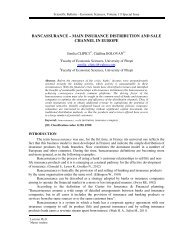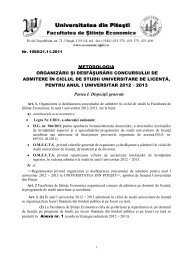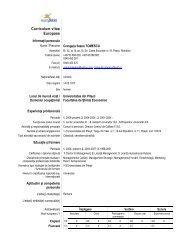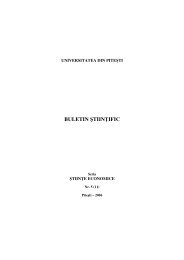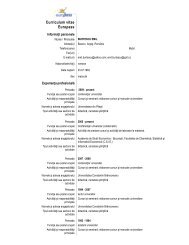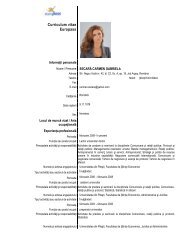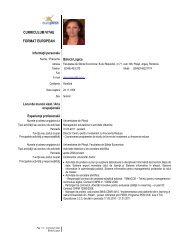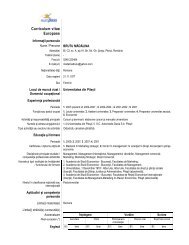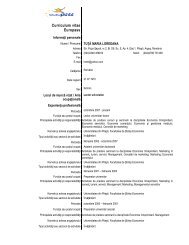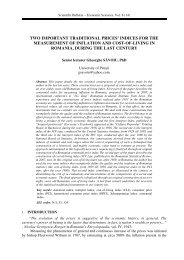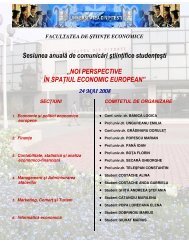buletin Åtiin ific - Facultatea de Stiinte Economice - Universitatea din ...
buletin Åtiin ific - Facultatea de Stiinte Economice - Universitatea din ...
buletin Åtiin ific - Facultatea de Stiinte Economice - Universitatea din ...
- No tags were found...
Create successful ePaper yourself
Turn your PDF publications into a flip-book with our unique Google optimized e-Paper software.
Scient<strong>ific</strong> Bulletin – Economic Sciences No. 7 (13)The importance of actuarial accounting for the assessment of the elements ofthe financial statementsUniversity Senior Lecturer PhD. Victoria FIRESCUUniversity of Piteştifirescuvictoria@yahoo.comAbstractActuarial accounting as a new evaluation basis and its associated present values or utility values arementioned in relation to the normalization accounting of asset <strong>de</strong>preciation. For example, theAmerican Financial Accounting Standards Board (FASB) published, in 1995, FAS 121, a standardconcerning the accounting treatment of the <strong>de</strong>preciation of long-term assets, while the InternationalAccounting Standards Board (IASB) approved IAS 36 standard "Asset Depreciation" concerning themeasurement and recognition of an asset impairment, when the recoverable value of the asset is lowerthan its book value. The standard concerns the <strong>de</strong>preciation of tangible and intangible assets.Key words: recoverable value, <strong>de</strong>preciation,fair value,utility valueIntroductionThe utility value is a discounted value that is measured by evaluating future expectedcash flows from the continuous usage of an asset and from its transfer, at the end of its economiclife. IAS 36 “Asset Depreciation” reflects the procedures used by an entity to <strong>de</strong>termine whetherits assets are <strong>de</strong>preciated, i.e. whether they are entered with a higher value than their recoverablevalue. IAS 36 also specifies when a company must resume an impairment loss and recommendsthat certain information related to the <strong>de</strong>preciated assets should be presented.The standard is applied in the accounting of all the assets’ <strong>de</strong>preciation, except those thatconstitute the scope of other standards: stocks (IAS 2, « Stocks »), assets of the constructionagreement assets (IAS 11, « Agreements for Constructions »), etc.In or<strong>de</strong>r to <strong>de</strong>termine whether a re-evaluated asset can be <strong>de</strong>preciated, the basis used forthe measurement of its fair value should be consi<strong>de</strong>red.1. The calculation of the recoverable value and the assessment of the impairment lossIn compliance with IAS 36, the recoverable value is the highest value of: the fair value ofan asset or of a cash-generating unit less costs to sell and its value in use.In or<strong>de</strong>r to calculate the recoverable value of one asset there are three applicable rules:- if the fair value, except the costs to sell, or the value in use of the asset, are higher thanits book value, the recoverable value is no longer calculated or estimated, because the active isnot <strong>de</strong>preciated ;- if the fair value, except the costs to sell cannot be calculated, the recoverable value of theasset can be regar<strong>de</strong>d as its value in use;- if the asset is owned with the special purpose of being sold, the recoverable value can beregar<strong>de</strong>d as its fair value, except the costs to sell.In or<strong>de</strong>r to exemplify the method of calculating the recoverable value and fin<strong>din</strong>g whether thereis an asset impairment loss for each accounting period, we take into account the followinginformation related to the fair value less the costs to sell (VJN), the utility value (VU) and the netbook value (VNC) of an item of technological equipment:a) year N : VJN=150,000 m.u., VU=225,000 m.u., VNC=180,000 m.u. ;b ) year N +1 : VJN=108,000 m.u., VU=96,000 m.u., VNC=120,000 m.u. ;c ) year N +2 : VJN=133,000 m.u., VU=175,000 m.u., VNC=140,000 m.u.62




